Around 1.25 million people in the United States of America have type 1 diabetes. Diabetes affects everyday life. If you don’t get treatment, you will have serious consequences. So what is Type 1 Diabetes, and how do you treat it?
If you have Type 1 Diabetes this means that there is more sugar in your blood than necessary. Our bodies need insulin to enable our cells to accept the sugar and convert it to energy. Insulin comes from the pancreas. Insulin is made in beta cells. Beta cells are the only cells in the body that can make insulin. When the pancreas works correctly, it makes sufficient insulin to let the sugar go to the cells in our body. When someone has Type 1 Diabetes, their body does not create insulin, resulting in all of the sugar stuck in their bloodstream. The reason people get Type 1 Diabetes is because their immune system confuses insulin with harmful germs, which they then try to fight off, destroying all beta cells.
Currently, there is no cure, but by using insulin pumps, you can help your body get the right amount of insulin. People with Type 1 Diabetes need to use insulin pumps to help guide the sugar into their cells, and produce energy. The insulin pump gives you a steady flow of insulin during the day. The dose of insulin depends on the person using the pump. The pump gives you insulin through a tube, the cannula. The tube is positioned right under the top layer of skin. The daily dose is called the basal, but pumps can also give out an insulin bolus. This is when the patient needs extra insulin in addition to the original set amount. These extra doses are hand-set. The insulin pumps cannot detect when the patient needs insulin, so the patient needs to program the pumps according to their needs. A few pumps can modify themselves based on the blood sugar reading from a glucose monitor that runs constantly.




